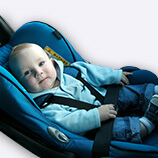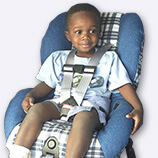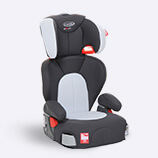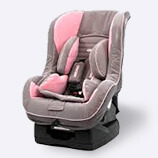5
Different Types of Car Seats
Car seats come in diverse models, pertaining to the various age groups of children and according to their height and weight. Some of the major types of car seats you will find available are –

This is the car seat you should ideally bring your infant home in, for the first time, from the hospital. As the name suggests, the child is seated facing the rear in this model, which provides maximum protection to the highly vulnerable and extremely fragile body of your newborn.

When your little one enters toddlerhood, he is ready to turn about and face the world - literally! This forward facing model allows your toddler to explore the world racing past through the window, while still restraining him firmly from unwanted movements and unnecessary injury.

Booster seats do not have any restraints to hold children in place. Instead, they only raise their position such that the car's seat belt fits them properly. These are best for preschoolers and older children- those who have outgrown the forward facing seats.

Some car seats are designed to work in both rear-facing and forward-facing modes. However, these seats are not suitable for newborns, are heavier and less portable.
Please note, all car seat models discussed here are made by manufacturers in accordance with the regional norms prescribed by that particular state/region. Most adhere to United Nations & European Safety Standard ECE R44/04. These seats are designed to meet the specific safety needs for every stage of your child's early years.
While the types mentioned above are based on the characteristics of various car seats, norms in US and UK classify the child car seats into various groups, as shown in the table -

Rear-facing Infant Seats
This is the car seat you should ideally bring your infant home in, for the first time, from the hospital. As the name suggests, the child is seated facing the rear in this model, which provides maximum protection to the highly vulnerable and extremely fragile body of your newborn.

Forward-facing Toddler Seats
When your little one enters toddlerhood, he is ready to turn about and face the world - literally! This forward facing model allows your toddler to explore the world racing past through the window, while still restraining him firmly from unwanted movements and unnecessary injury.

Booster Seats for Older Children
Booster seats do not have any restraints to hold children in place. Instead, they only raise their position such that the car's seat belt fits them properly. These are best for preschoolers and older children- those who have outgrown the forward facing seats.

Convertible & Combination Car Seats
Some car seats are designed to work in both rear-facing and forward-facing modes. However, these seats are not suitable for newborns, are heavier and less portable.
| Approximate Weight Range | Approximate Age Range | Group | Stage |
|---|---|---|---|
| From birth to 9 kg (20 lbs) | Newborn to 9 months | 0 | Infant |
| From birth to 13 kg (29 lbs) | Newborn to 15 months | 0+ | Infant |
| 2-3 kg to 13 kg (4-6 lbs to 29 lbs) | Newborn to 24 months | 0+ & 1 | Infant |
| 09 kg to 18 kg (20 lbs to 40 lbs) | 9 months to 4 years | 1 | Toddler |
| 15 kg to 25 kg (33 lbs to 55 lbs) | 4 years to 6 years | 2 | Toddler |
| 22 kg to 36 kg (48 lbs to 76 lbs) | 4 years to 11 years | 3 | Grown up Child |
Choosing the Best Car Seat for Your Child
We have discussed in brief the different types of car seats available in the market and the features you should look for in the one you buy. In this section, let us venture deeper into the various types. We will explore each type in all its detail, and consider all you need to know about a particular model before you're ready to make a buying decision. We will also help you choose the model that suits your child best through our Buyer Recommendation Form (link to the form). Make sure you go through all the details thoroughly before arriving at the model you think is perfect for your little one.
Which Car seat would suit my child
Who is the car seat for?
Which Car seat would suit my child
OR Enter age of child
Newborn



